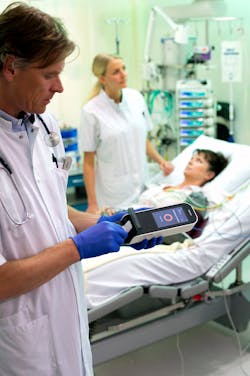Handheld blood test uses optical detection to diagnose a heart attack at the point of care
Royal Philips (Amsterdam, The Netherlands) has developed a handheld blood testing device that rapidly diagnoses heart attack at the point of care. The handheld Minicare I-20 device measures the level of cardiac troponin I (cTnI), a protein that is excreted by the heart muscle into the blood following a heart attack. It delivers test results, comparable with those obtained by laboratory testing, in less than 10 minutes near the patient, reducing the time for a physician to decide on the appropriate treatment pathway.
Related: Optical sensor-driven device can count white blood cells through the skin
The Minicare I-20 system consists of a connected handheld analyzer, dedicated software, and a single-use disposable cartridge containing an application-specific test based on the company's Magnotech biosensor technology, which involves the controlled movement of magnetic nanoparticles.With the biosensor, specific molecules that relate to the antibodies on the particles are the only ones captured. An electromagnet draws the particles to the surface, where those particles that have captured a target molecule are then bound. A reversed magnetic field enables a fast and controlled separation between the bound and unbound particles. Using optical detection, the number of bound particles is quantified, enabling the analyte concentration in the sample to be determined. The lab-comparable test results are displayed on the analyzer within 10 minutes.
The Minicare I-20 was tested in real-life acute care settings within the European Lab2Go project (Eindhoven, The Netherlands), a consortium of European hospitals. It is now being introduced in selected countries in Europe, including the UK, Germany, The Netherlands, and Belgium, with introduction in other European countries to follow.
For more information, please visit www.usa.philips.com.

